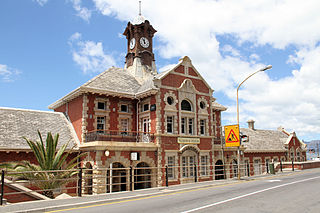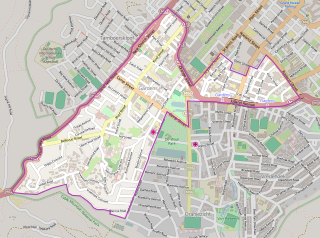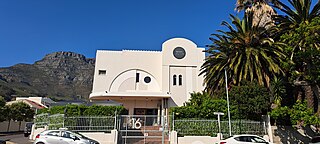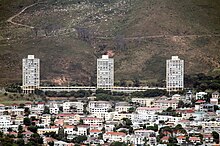
Table Mountain is a flat-topped mountain forming a prominent landmark overlooking the city of Cape Town in South Africa. It is a significant tourist attraction, with many visitors using the cableway or hiking to the top. Table Mountain National Park is the most visited national park in South Africa, attracting 4.2 million people every year for various activities. The mountain has 8,200 plant species, of which around 80% are fynbos, meaning fine bush. It forms part of the Table Mountain National Park, and part of the lands formerly ranged by Khoe-speaking clans, such as the !Uriǁʼaes. It is home to a large array of mostly endemic fauna and flora.

Sea Point is an affluent and densely populated suburb of Cape Town, situated between Signal Hill and the Atlantic Ocean, a few kilometres to the west of Cape Town's Central Business District (CBD). Moving from Sea Point to the CBD, one passes first through the small suburb of Three Anchor Bay, then Green Point. Seaward from Green Point is the area known as Mouille Point, where the local lighthouse is situated. It borders to the southwest the suburb of Bantry Bay. It is known for its large Jewish population, synagogues, and kosher food options.

Glenhazel is a suburb of the Municipality of Johannesburg, South Africa. It is located in Region E, bordering Fairmount, Sandringham, Lyndhurst and Percelia Estate. The area lies on a sloping hill with a park in the valley. It is known for its large Jewish population as well as for being home to the largest Jewish kosher hub in Johannesburg, which attracts many Jewish tourists.

Muizenberg is a beach-side town in the Western Cape, South Africa. It is situated where the shore of the Cape Peninsula curves round to the east on the False Bay coast. It is considered to be the main surfing spot in Cape Town and is currently home to a surfing community, centered on the popular 'Surfer's Corner'.

Disa Park is one of the best-known pieces of architecture in the Vredehoek area of Cape Town, South Africa. The towers were built in response to a "white housing crisis" in the city and completed in 1969. The buildings were designed by architectural firm Bergamasco, Duncan & James, they also designed most of the contemporary Catholic churches in Cape Town.

Woodstock is one of the earliest suburbs of Cape Town, South Africa, between the docks of Table Bay and the lower slopes of Devil's Peak, about 1 kilometre (0.6 mi) east of the city centre of Cape Town. Woodstock is served by Woodstock and Esplanade railway stations, and has the postal code 7925 for street addresses and 7915 for post office box deliveries.

Table Mountain National Park, previously known as the Cape Peninsula National Park, is a national park in Cape Town, South Africa, proclaimed on 29 May 1998, for the purpose of protecting the natural environment of the Table Mountain Chain, and in particular the rare fynbos vegetation. The park is managed by South African National Parks. The property is included as part of the UNESCO Cape Floral Region World Heritage Site.

Gardens is an affluent inner-city suburb of Cape Town located just to the south of the city centre located in the higher elevations of the "City Bowl" and directly beneath Table Mountain and Lion's Head. It is home to several national museums such as Iziko South African National Gallery and the Iziko South African Museum. The University of Cape Town also houses its Fine Arts department in the suburb, at Michaelis School of Fine Art. Company's Garden, South Africa's oldest garden, a public park and heritage site is a focal point of the suburb. The area is also home to the oldest synagogue in Southern Africa, the Old Shul and its successor, the Gardens Shul, "The Mother Synagogue of South Africa."

Green Point is an affluent suburb on the Atlantic Seaboard of Cape Town, South Africa located to the north west of the central business district and. It is home to Cape Town Stadium, a major sporting venue that was built for the 2010 FIFA World Cup. Sea Point promenade runs through the suburb, connecting it to Three Anchor Bay and Sea Point, a popular Jewish neighbourhood. Somerset Road forms the main thoroughfare lined by restaurants, cafés, delis, boutiques and nightclubs.
The Yeshiva of Cape Town is a kollel and yeshiva established in 1994. Its full title is "The Rabbi Cyril and Ann Harris Yeshiva of Cape Town", named for the late Chief Rabbi. It is based in the Green and Sea Point Hebrew Congregation, in the suburb of Sea Point, Cape Town.

The Gardens Shul, formally, the Cape Town Hebrew Congregation (CTHC) is a Modern Orthodox synagogue located in the Company Gardens, in the Gardens neighborhood of Cape Town. It has the oldest Jewish congregation in South Africa, dating to 1841. The congregation, known as "The Mother Synagogue of South Africa," possesses two historic structures, the 1863 synagogue known as the Old Shul and the 1905 synagogue. The South African Jewish Museum, located in its grounds, also occupies the Old Shul and is responsible for its upkeep. The 1905 building is an example of Edwardian architecture and has been called "one of the most magnificent synagogues in the world."
The United Herzlia Schools is an organisation that manages the delivery of separate Jewish education in Cape Town in South Africa.

Cecilia is a section of the Table Mountain National Park on the lower eastern slopes of Table Mountain in Cape Town, located just to the south of Kirstenbosch National Botanical Garden. It was previously used for commercial logging and known as Cecilia Forest or Cecilia Plantation, but has now been given protected status and integrated into the National Park.

Devil's Peak Estate is a suburb of Cape Town, South Africa in the area known as the City Bowl. It is sandwiched between Vredehoek and Zonnebloem on the slopes of Devil's Peak. According to the 2011 census it has a population of 1,859 residents in an area of 0.46 square kilometres (0.18 sq mi).
Rabbi Barry Marcus is a South African rabbi. He retired as senior minister of Central Synagogue, Great Portland Street in London in 2018 after serving the congregation for over 24 years. He is notable for his rabbinical and pastoral duties in the UK, Israel and South Africa.

The following outline is provided as an overview of and topical guide to Cape Town:

The 2021 Table Mountain fire is a major fire that started on 18 April 2021 in and around Table Mountain National Park and the neighbourhoods of Newlands, Rosebank, Mowbray and Rondebosch in Cape Town, South Africa. The damage to sites in the Table Mountain area included the Rhodes Memorial, where a restaurant burned down; the upper campus of the University of Cape Town (UCT), where the Special Collections library was gutted; and Mostert's Mill, a historic windmill that burned down. In addition, five firefighters were hospitalised.

The Marais Road Shul, formally, the Green & Sea Point Hebrew Congregation (G&SPHC) is a notable Modern Orthodox synagogue in Sea Point, a seaside suburb of Cape Town. The congregation was first established in 1926, and the synagogue was completed in 1934. It had initially intended to become a branch of the Gardens Shul in the City Bowl, but opted for independence, and became the larger of the two. It is the largest Jewish congregation in South Africa, and by 1994, it had become the largest in the South Hemisphere. The Sephardi Hebrew Congregation, established in 1960, also operates a shul from the G&SPHC's Weizmann Hall on Regent Road in Sea Point.

The Vredehoek Shul, formally the Cape Town Hebrew Congregation, was a Modern Orthodox synagogue in Vredehoek in Cape Town. It was established in 1939 and closed in 1993. It was one of a number of synagogues in the City Bowl, along with the country's oldest synagogue, the Gardens Shul in Gardens. The Art Deco building is a protected South African Heritage Resources Agency site and currently operates as Private Collection, an antique furniture showroom.
The Beit Midrash Morasha at Arthur's Road is a Modern Orthodox synagogue in Sea Point, a seaside suburb of Cape Town. The congregation was first established in 1897 in District Six, before relocating to Vredehoek in 1945. It moved to its present location on Arthur's Road in Sea Point in 1954.


























